Latest Thread
You are using an out of date browser. It may not display this or other websites correctly.
You should upgrade or use an alternative browser.
You should upgrade or use an alternative browser.
Live Conflict Myanmar Civil War
- Thread starter Mis_TR_Like
- Start date
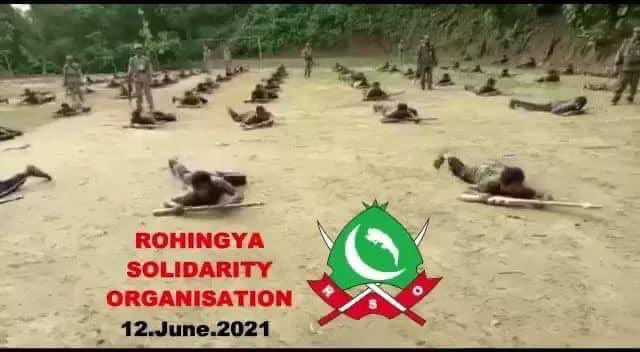
Defunct Rohingya Solidarity Organisation (RSO) reappeared on social media to pledge fight against the Military regime - Defense Politics Asia
The Rohingya Solidarity Organisation (RSO), a political organisation founded in 1982, which armed branch had merged into the Rohingya National Army (RNA) in 1998, had reappeared on social media, pledging to fight the "facist military" and fight for the human rights of the Rohingya people...
 defensepoliticsasia.com
defensepoliticsasia.com
F-6 enthusiast
Well-known member
Hope this is useful. I found Some background information on Burmese civil war and the Ethnic Armed Organisations fighting against Tatmadaw.Thank you for your insight! I am amazed every time I enter this thread by the intensity of the conflict and the casualty numbers. My Twitter is absolutely silent about the whole situation. Now I am more interested into this conflict and would like to learn more about it.
Part 1
There are many more ethnic groups with their own armies, among them Wa State is the best equipped with SAMs , artillery etc plus they use Chinese currency too.
Woah! That's more complicated than I was thinking. Thanks!Hope this is useful. I found Some background information on Burmese civil war and the Ethnic Armed Organisations fighting against Tatmadaw.
Part 1
Part 2 Arakan Army
Part 3 Karen
Part 4 Kachin
Who is supplying MANPADs to Arakan Army ?
There are many more ethnic groups with their own armies, among them Wa State is the best equipped with SAMs , artillery etc plus they use Chinese currency too.
Woah! That's more complicated than I was thinking. Thanks!
Shan area has always been a buffer zone historically along with neighbouring Yunnan (between Burma and China proper). I believe @Saithan has visited Yunnan.
IIRC, Invasions of Burma by China (to help allied-Thailand out in a number of instances when it was in turn being invaded by Burma) generally proceeded through passes in the Shan (Keng-Tung, Lashio are the big 2). Lashio is now more famous due to the burma (supply) road during WW2.
Hence why ethnically, lot of kin to Han people are settled there in Shan, especially in the border zones....and you have their militias representing them and being the defacto govt there.... given paucity of trust in central Bamar authority (and generally any other burmese groups in general).
BTW, (Qing) Chinese could not make any real headway into Burmese heartland and lot of armies were totally obliterated in burmese counter-offensives...given the narrow-pass terrain. This is similar to the majority of IndoChina in general (except for arguably the large flat Thai plain) as it suits defender+chokepoint+garrison strategy immensely and punishes extended and tenuous logistics chains commensurately. Somewhat in contrast to the large open swathes Chinese+Mongol armies were used to in their homelands with the strategies developed there.
But one can say Burma is no stranger to war and its continuing legacy to this day.
@Joe Shearer @Saiyan0321 @Anmdt @VCheng
Shan area has always been a buffer zone historically along with neighbouring Yunnan (between Burma and China proper). I believe @Saithan has visited Yunnan.
IIRC, Invasions of Burma by China (to help allied-Thailand out in a number of instances when it was in turn being invaded by Burma) generally proceeded through passes in the Shan (Keng-Tung, Lashio are the big 2). Lashio is now more famous due to the burma (supply) road during WW2.
Hence why ethnically, lot of kin to Han people are settled there in Shan, especially in the border zones....and you have their militias representing them and being the defacto govt there.... given paucity of trust in central Bamar authority (and generally any other burmese groups in general).
BTW, (Qing) Chinese could not make any real headway into Burmese heartland and lot of armies were totally obliterated in burmese counter-offensives...given the narrow-pass terrain. This is similar to the majority of IndoChina in general (except for arguably the large flat Thai plain) as it suits defender+chokepoint+garrison strategy immensely and punishes extended and tenuous logistics chains commensurately. Somewhat in contrast to the large open swathes Chinese+Mongol armies were used to in their homelands with the strategies developed there.
But one can say Burma is no stranger to war and its continuing legacy to this day.
@Joe Shearer @Saiyan0321 @Anmdt @VCheng
My uncle fought in Burma during WW2. It is a hellish area to fight a war, no doubt, and doubly so for invaders

Myanmar Military Truck With Soldiers on Board Blown Up in Yangon
No details yet on casualties but body parts can be seen in photos of the scene; the apparent bombing is the most serious attack yet on a regime target in the city.
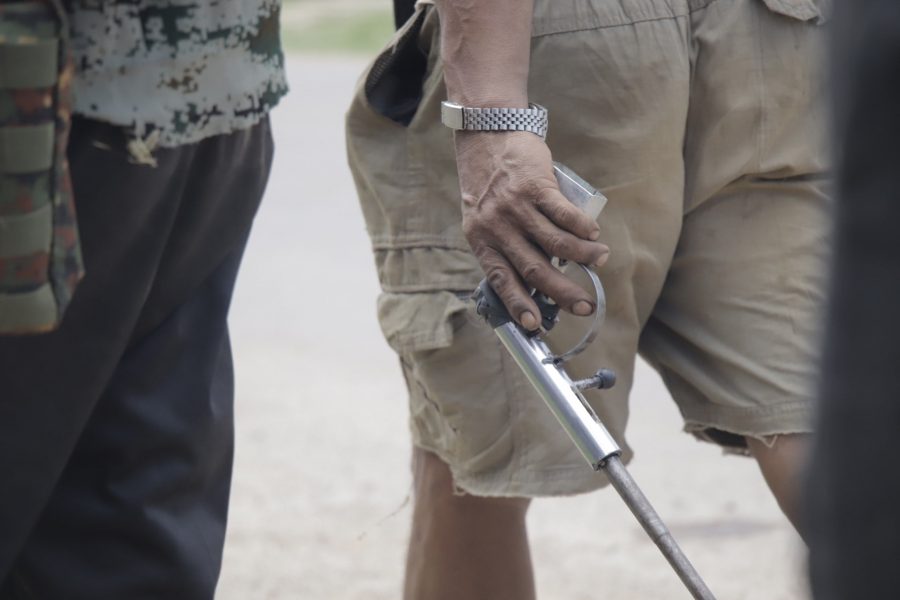
Kayah State Resistance Groups Reject Ceasefire with Myanmar Junta
Young civilian resistance fighters say ceasefire announced without their agreement.
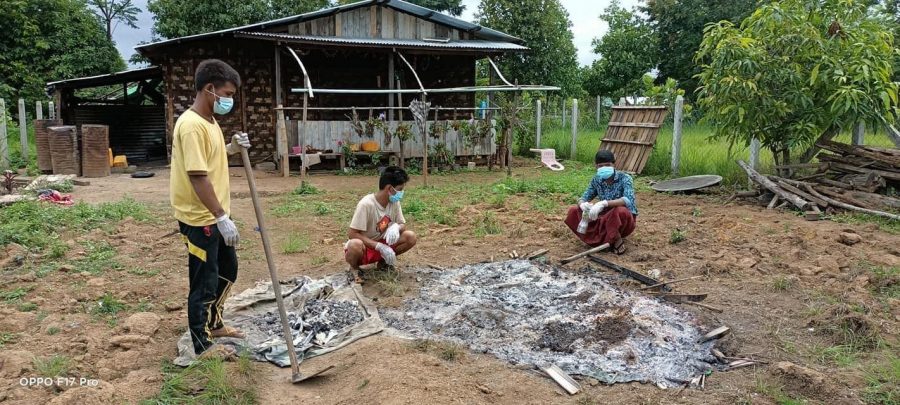
Unidentified Bodies Found After Myanmar Junta Troops Occupy Kayah Village
Residents of Demoso Township who fled fierce fighting returned to their homes to find over a dozen barely recognizable corpses.
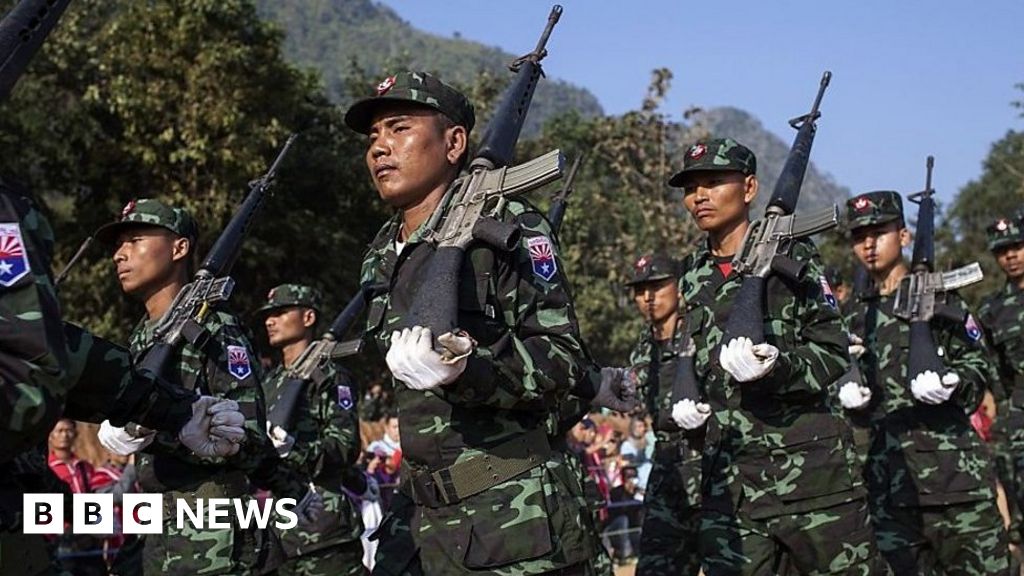
Myanmar: Who are the ethnic armies training protesters?
Many protesters are being trained by ethnic armed groups - can they eventually topple the junta?
P
Philips
Guest
Rebels and army fight in Mandalay city:
Mandalay PDF ‘declares war’ on junta
‘The day we’ve been waiting for is finally here,’ a member of the civilian resistance says as clashes break out in the city
Gunfire was exchanged between the regime’s armed forces and a civilian guerrilla group in Mandalay’s Chanmyatharzi Township on Tuesday morning after an attempted raid by the junta on the group’s location.
Representatives of the Mandalay People’s Defence Force (Mandalay PDF) said that around 20 soldiers carried out the raid at around 8am, igniting one of the first clashes between a PDF and the military in a major urban area.
“They came here because they received information about where we were. But we knew beforehand that they were coming so we had the upper hand,” said Mandalay PDF spokesperson Bo Tun Tauk Naing, adding that fighting was still ongoing at the time of reporting.
The number of casualties had not yet been confirmed.
“The members of the public in the area have moved to safety, and we have not backed down. We’ll continue to fight,” Bo Tun Tauk Naing said. “We’ve declared war. The day we’ve been waiting for is finally here.”
At 9am he told Myanmar Now that the members of his group who had taken cover in a nearby building had been arrested by the junta’s armed forces.
“Our other members are still shooting from outside. We don’t know how many of our members have been arrested, but we’re spread out across the entire city. It’s like losing one finger out of a whole hand,” he explained.
Mandalay locals told Myanmar Now that the military was patrolling in the city with at least three armoured vehicles in search of suspects involved in the shootout.
The military-controlled Myawaddy TV announced on Tuesday afternoon that so-called “terrorists” had opened fire on regime troops when they went to inspect a location at the intersection of 54th and 111th streets where the resistance had allegedly been storing explosives.
The announcement claimed that “some” members of the armed forces were injured during the shootout, but did not specify a number. Myawaddy TV reported that four members of the “terrorist group” were killed and eight were arrested in possession of makeshift bombs and other light weapons.
The announcement also said that four more people from the civilian resistance died in a car crash after their vehicle was pursued by regime troops from 53rd St.
The Mandalay PDF did not confirm the military’s claims and Myanmar Now was not able to verify the information at the time of reporting.
A local rescue team volunteer told Myanmar Now that its members provided medical treatment to at least two civilians who were injured by rubber bullets during the Tuesday morning shootout.
The Mandalay PDF previously targeted police and soldiers on security duty, as well as the military council’s administrative offices and the buildings of military-run businesses.
On June 1, a regime soldier was killed and another seriously injured when the PDF members opened fire on military trucks in the city. On June 8, two policemen were shot dead.
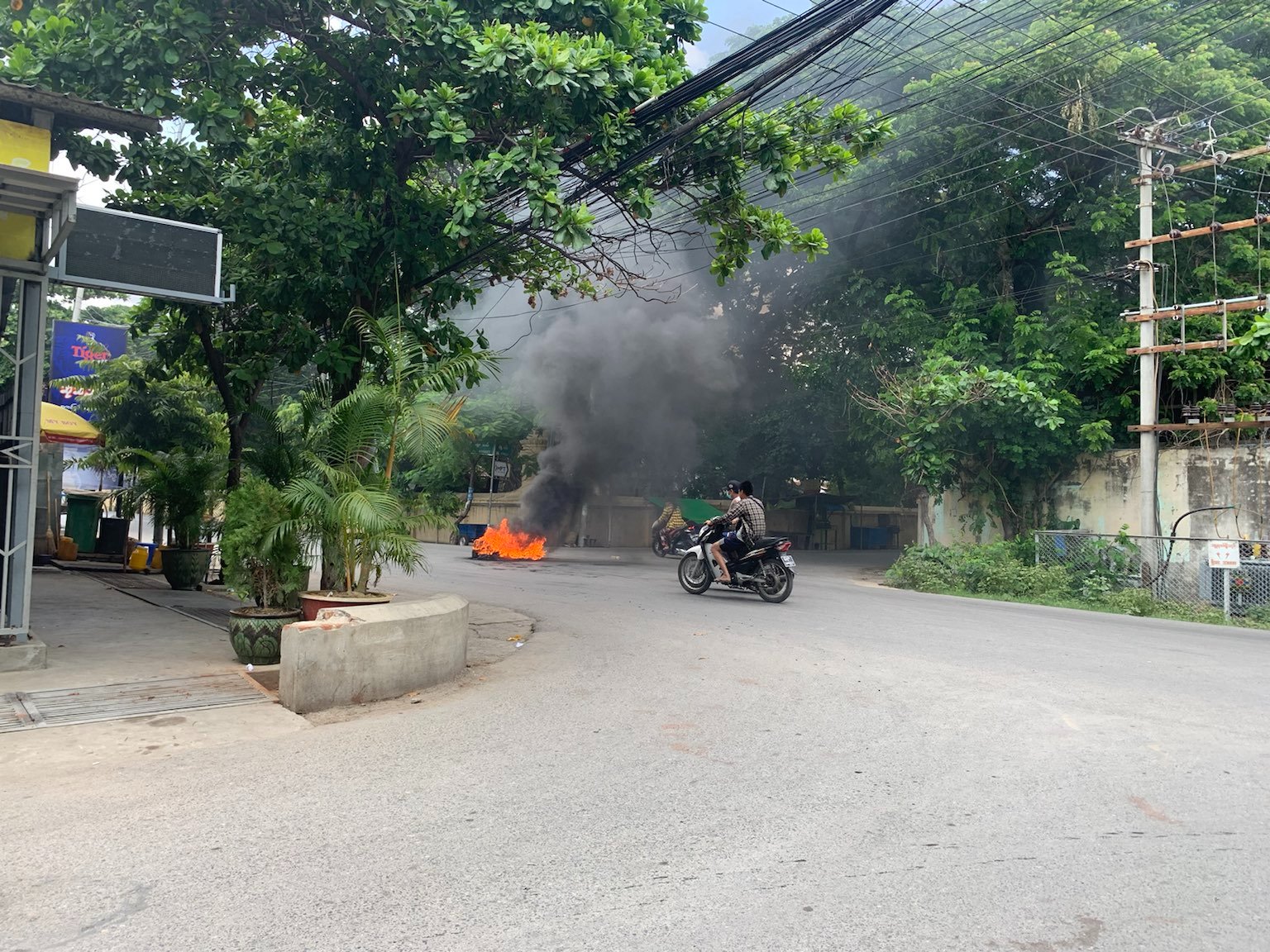
 www.myanmar-now.org
www.myanmar-now.org
Mandalay PDF ‘declares war’ on junta
‘The day we’ve been waiting for is finally here,’ a member of the civilian resistance says as clashes break out in the city
Gunfire was exchanged between the regime’s armed forces and a civilian guerrilla group in Mandalay’s Chanmyatharzi Township on Tuesday morning after an attempted raid by the junta on the group’s location.
Representatives of the Mandalay People’s Defence Force (Mandalay PDF) said that around 20 soldiers carried out the raid at around 8am, igniting one of the first clashes between a PDF and the military in a major urban area.
“They came here because they received information about where we were. But we knew beforehand that they were coming so we had the upper hand,” said Mandalay PDF spokesperson Bo Tun Tauk Naing, adding that fighting was still ongoing at the time of reporting.
The number of casualties had not yet been confirmed.
“The members of the public in the area have moved to safety, and we have not backed down. We’ll continue to fight,” Bo Tun Tauk Naing said. “We’ve declared war. The day we’ve been waiting for is finally here.”
At 9am he told Myanmar Now that the members of his group who had taken cover in a nearby building had been arrested by the junta’s armed forces.
“Our other members are still shooting from outside. We don’t know how many of our members have been arrested, but we’re spread out across the entire city. It’s like losing one finger out of a whole hand,” he explained.
Mandalay locals told Myanmar Now that the military was patrolling in the city with at least three armoured vehicles in search of suspects involved in the shootout.
The military-controlled Myawaddy TV announced on Tuesday afternoon that so-called “terrorists” had opened fire on regime troops when they went to inspect a location at the intersection of 54th and 111th streets where the resistance had allegedly been storing explosives.
The announcement claimed that “some” members of the armed forces were injured during the shootout, but did not specify a number. Myawaddy TV reported that four members of the “terrorist group” were killed and eight were arrested in possession of makeshift bombs and other light weapons.
The announcement also said that four more people from the civilian resistance died in a car crash after their vehicle was pursued by regime troops from 53rd St.
The Mandalay PDF did not confirm the military’s claims and Myanmar Now was not able to verify the information at the time of reporting.
A local rescue team volunteer told Myanmar Now that its members provided medical treatment to at least two civilians who were injured by rubber bullets during the Tuesday morning shootout.
The Mandalay PDF previously targeted police and soldiers on security duty, as well as the military council’s administrative offices and the buildings of military-run businesses.
On June 1, a regime soldier was killed and another seriously injured when the PDF members opened fire on military trucks in the city. On June 8, two policemen were shot dead.

Mandalay PDF ‘declares war’ on junta
‘The day we’ve been waiting for is finally here,’ a member of the civilian resistance says as clashes break out in the city
Myanmar Junta Troops Battle Civilian Resistance Fighters in Mandalay
Junta snipers on a building in Mandalay during the clash on Tuesday. / CJ
By THE IRRAWADDY 22 June 2021
Junta forces raided a base of the People’s Defense Force (PDF) in Mandalay on Tuesday morning, resulting in a clash.
Junta troops reportedly raided a boarding school where PDF fighters were based in Hton Tone ward at around 7.30 a.m.
“They sniffed us out. They came to our base at between 111st and 112nd streets on 54th Street and we shot at them as they came,” said the person in charge of the Mandalay PDF’s urban guerilla warfare unit who uses the pseudonym Bo Tun Tauk Naing.
PDF fighters were withdrawing from the base as their colleagues from other parts of the town rushed to rescue them.
“I heard three of our fighters have been injured. We don’t know yet how many have been detained. Our weapons will be seized if they [junta troops] are able to overrun our base. But they won’t be seized if our troops can retreat successfully,” Bo Tun Tauk Naing said.
Junta forces used grenades in the fighting, the PDF said. Junta troops are also using snipers and armored vehicles in the clash.
“Junta troops arrived around 7 a.m. and opened fire at 111st and 54th streets. It was not heavy shooting. Then there was an exchange of fire between 8 a.m. and 8.30 a.m. So far, junta troops have not yet raided houses. But they are detaining every man on sight,” said a resident of Hton Tone Ward.
He said he heard the sounds of machine guns and grenades. Locals are staying indoors during the shootout.
The Mandalay PDF was formed by local resistance fighters who underwent military training provided by ethnic armed groups. They operate under the parallel National Unity Government.
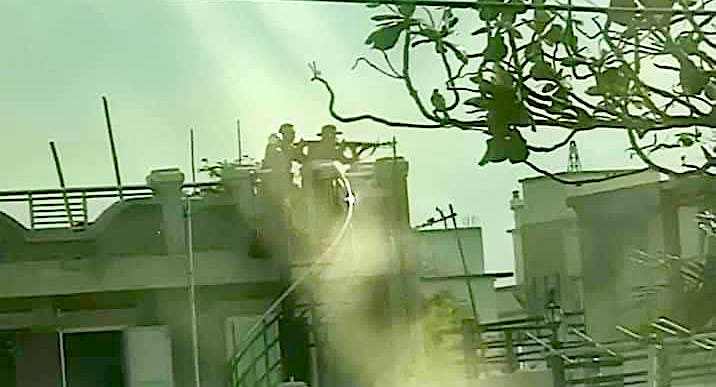
Myanmar Junta Troops Battle Civilian Resistance Fighters in Mandalay
Regime forces attacked a PDF base in Hton Tone Ward; resistance fighters from other locations were attempting to help the PDF forces evacuate with their weapons.
Fighting broke out between the Myanmar military and the Karen National Liberation Army (KNLA) in four locations outside the Karen State capital of Hpa-an on Monday, killing eight junta troops, according to the Karen National Union (KNU).
The KNLA, the armed wing of the KNU, clashed with the regime’s armed forces in the areas of Lay Taw Gyi, Melan, Guh Bee Htwee, and Mee Bon in the Karen forces’ Brigade 1 territory, some 20 miles from Hpa-an, a KNLA official told Myanmar Now.
“There was an intense shootout in Lay Taw Gyi and Mee Bon, but there were no casualties on our side. But at least eight military soldiers were killed and two injured,” he said.
On June 14, the KNLA’s Brigade 1 and the Myanmar army initially clashed in Hpa-an. The KNLA official blamed the fighting on the junta’s operations with its allied Border Guard Force (BGF) in the state.
Brigade 1 territory includes Bilin, Thaton, Hpa-an and Kyaikhto townships in both Mon and Karen states. Since the February 1 coup, there have been five clashes in Thaton and one in Kyaikhto, according to KNU and KNLA sources.
“Now, Bilin, Kyaikhto and Thaton are calm. There’s been no activity or confrontation,” a KNU official said.
The KNU’s Thoolei News reported that Monday’s clashes took place in four locations around Hpa-an, stating that eight junta soldiers had been killed and four injured.
It has been in the KNLA’s Brigade 3 and 5 territories that fighting has intensified since the coup, with the military suffering heavy casualties and tens of thousands of people displaced by the regime’s artillery fire and airstrikes.
In Brigade 5 alone, in Karen State’s Mutraw District (Hpapun), more than 350 regime troops have been killed, according to a colonel in the KNLA’s fifth brigade.
At the time of reporting, the KNLA in that area had overran at least two military bases and forced a retreat from at least three regime camps.
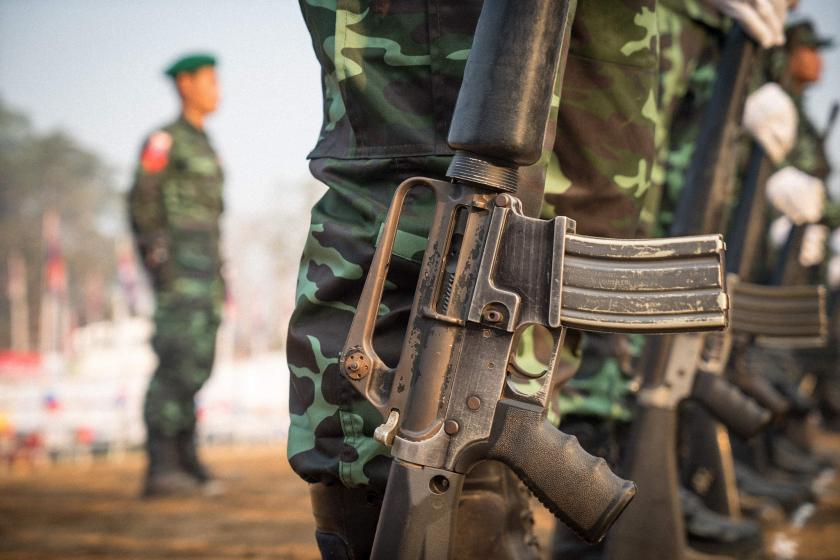
Eight regime soldiers killed in clashes around Hpa-an
Fighting breaks out in multiple locations some 20 miles outside the Karen State capital
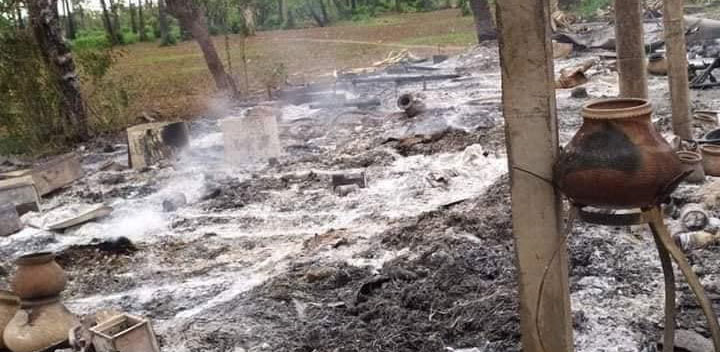
Around 30 Myanmar Junta Troops Killed in Sagaing
Civilian resistance fighters with homemade weapons appear to have defeated regime troops.

Myanmar Junta Colonel Killed in Raid on Mandalay Resistance
Lieutenant Colonel Aung Myo Kyaw was the highest-ranking junta officer killed since the February coup.
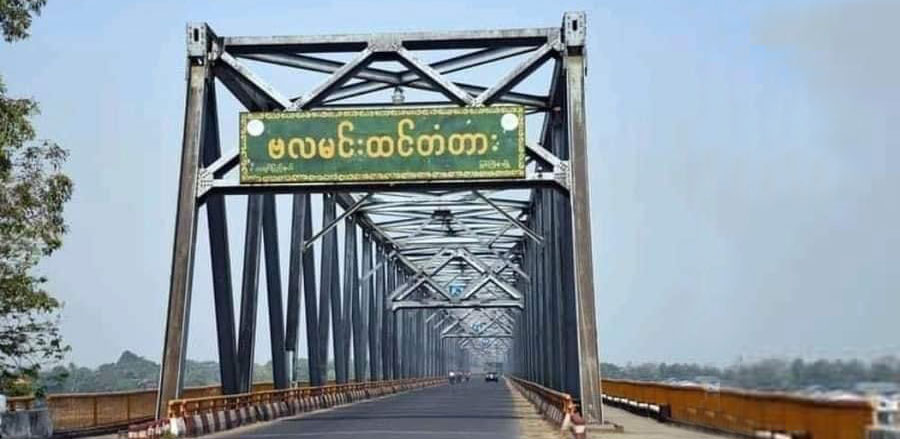
Myanmar Junta Police Wounded in KIA Attack
The ethnic armed group attacked a regime checkpoint just outside the Kachin State capital Myitkyina in the latest in a series of attacks on junta forces in northern Myanmar.

KIA attacks regime’s armed forces in Hpakant
The KIA reportedly ambushes a military convoy near the village of Sezin
Last edited:
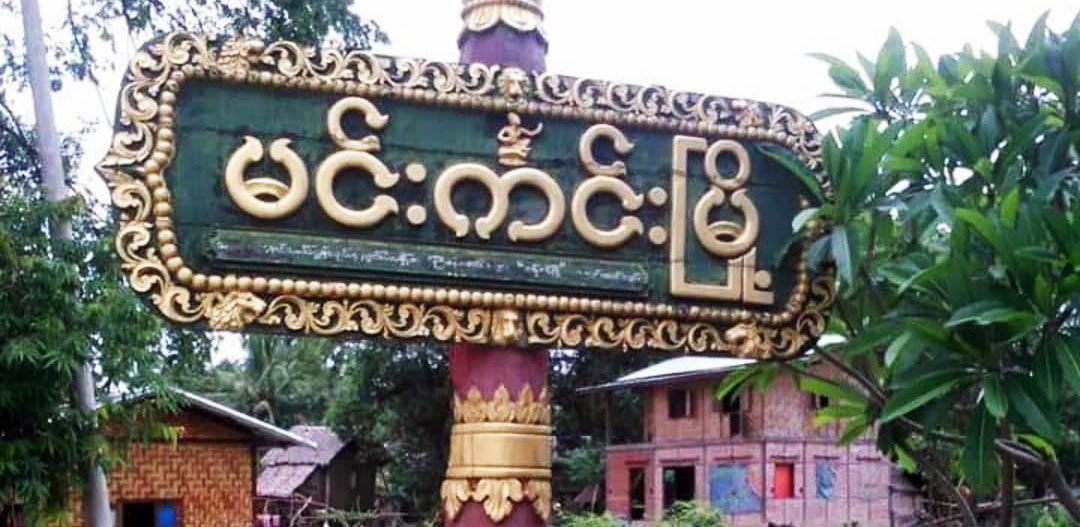
15 Myanmar Junta Troops Killed in Sagaing Region Firefights
Civilian resistance fighters clashed with regime soldiers in two shootouts in Mingin Township.
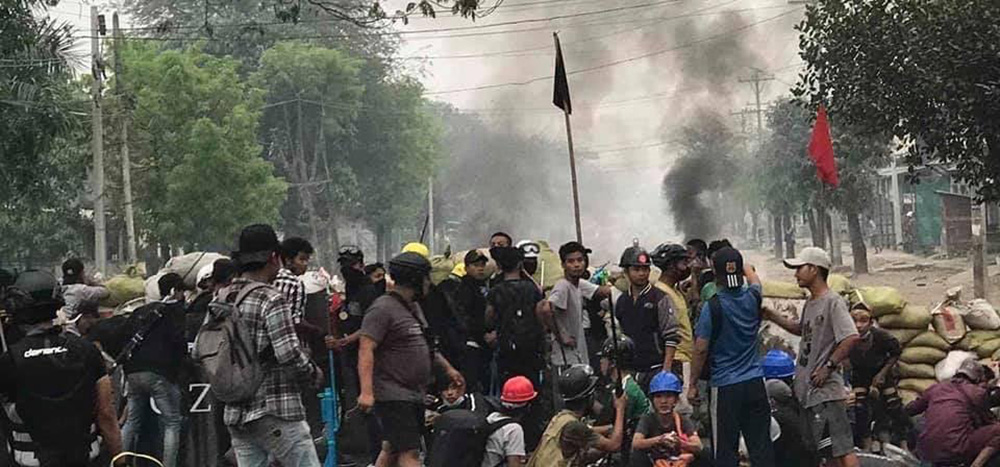
Nine Myanmar Junta Troops Killed in Sagaing: PDF
The Kale resistance forces say they successfully attacked the regime’s soldiers.
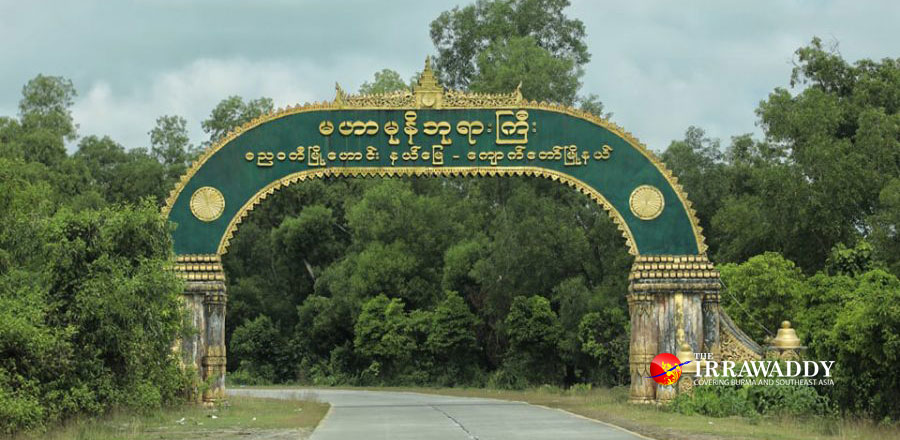
Arakan Army Seizes Weapons From Regime’s Police Force in Rakhine
The ethnic armed group had warned the military regime not to station junta forces at the Mahamuni Buddha Temple in Kyauktaw.
Around 40 junta soldiers were killed on Tuesday by civilian resistance fighters of the Chinland Defense Force (CDF) during fierce clashes in Chin State’s Hakha and Falam townships.
On Tuesday morning, a firefight erupted after 40 fighters of the CDF-Hakha raided a police outpost in Bungzung Village located on the Gangaw-Hakha highway.
At least 20 regime soldiers were killed during the subsequent six hour-long shootout with around 35 junta troops, while two civilian resistance fighters were injured, according to the spokesperson of CDF-Hakha.
“We had to attack the police outpost as a warning since they are prohibiting and exploiting the transportation of food between Gangaw and Hakha,” the spokesperson told The Irrawaddy on Wednesday.
Another shootout occurred on Tuesday when over 100 fighters from the Chin National Defense Force (CNDF) clashed with 100 junta troops from Falam and 100 regime reinforcements from Kalaymyo Township, Sagaing Region, who were attempting to raid a CNDF area.
During two hours of intense fighting near Wai Bu La Town in Falam Township, the junta forces used heavy explosives in their attacks.
The CNDF said in a statement that at least 20 junta soldiers were killed and several injured. Four civilian resistance fighters were killed and three others injured.
However, the Irrawaddy was unable to confirm independently the casualty counts from the two shootouts.
Locals in Falam Township have been warned by the CNDF to be alert as it expects the military regime forces to take revenge. The CNDF said also that it will protect the lives and properties of people and avoid taking actions that will lead to residents of the area being harmed.
Junta reinforcements have now been deployed in Hakha Township, and the CDF spokesperson said that there will be further firefights in the township if junta troops move into CDF areas.
Clashes broke out initially in Hakha on May 2 and continued through May 4 after junta forces refused to release detained anti-regime protesters.
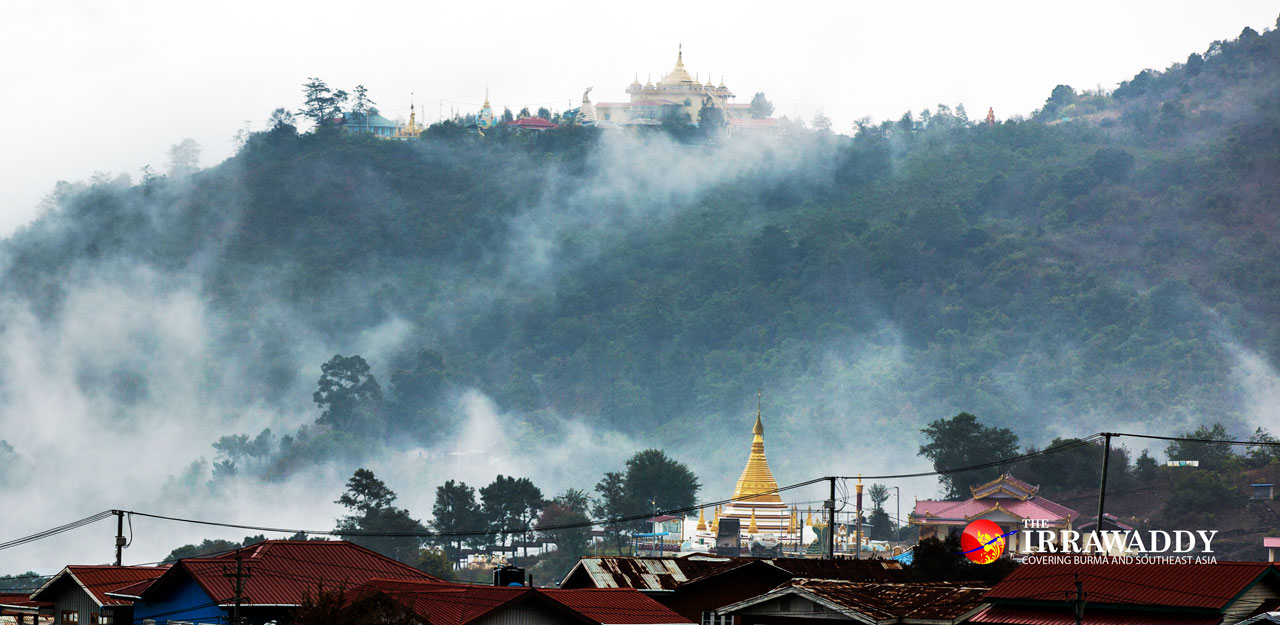
 www.irrawaddy.com
www.irrawaddy.com
On Tuesday morning, a firefight erupted after 40 fighters of the CDF-Hakha raided a police outpost in Bungzung Village located on the Gangaw-Hakha highway.
At least 20 regime soldiers were killed during the subsequent six hour-long shootout with around 35 junta troops, while two civilian resistance fighters were injured, according to the spokesperson of CDF-Hakha.
“We had to attack the police outpost as a warning since they are prohibiting and exploiting the transportation of food between Gangaw and Hakha,” the spokesperson told The Irrawaddy on Wednesday.
Another shootout occurred on Tuesday when over 100 fighters from the Chin National Defense Force (CNDF) clashed with 100 junta troops from Falam and 100 regime reinforcements from Kalaymyo Township, Sagaing Region, who were attempting to raid a CNDF area.
During two hours of intense fighting near Wai Bu La Town in Falam Township, the junta forces used heavy explosives in their attacks.
The CNDF said in a statement that at least 20 junta soldiers were killed and several injured. Four civilian resistance fighters were killed and three others injured.
However, the Irrawaddy was unable to confirm independently the casualty counts from the two shootouts.
Locals in Falam Township have been warned by the CNDF to be alert as it expects the military regime forces to take revenge. The CNDF said also that it will protect the lives and properties of people and avoid taking actions that will lead to residents of the area being harmed.
Junta reinforcements have now been deployed in Hakha Township, and the CDF spokesperson said that there will be further firefights in the township if junta troops move into CDF areas.
Clashes broke out initially in Hakha on May 2 and continued through May 4 after junta forces refused to release detained anti-regime protesters.

Dozens of Myanmar Junta Soldiers Killed in Chin State Clashes
Around 40 regime troops died in shootouts with civilian resistance fighters in Falam and Hakha Townships.
At least 25 people were killed by regime forces in the west of Tabayin Township in Sagaing Region on Friday.
Shootouts took place when the civilian resistance People’s Defense Force (PDF) defended Satpyarkyin village against some 150 artillery-supported regime troops on Friday morning.
During prolonged shootouts, at least 18 PDF members were killed and more than 10 injured, the PDF announced. The group said four junta soldiers were killed.
The group said at least 40 artillery shells were fired at the village. A boy was detained by troops while trying to escape.
A villager said more PDF members and four other civilian bodies have since been found, increasing the death toll to 25.
He said the resistance fighters were only armed with traditional firearms and withdrew on Friday night.
“We can’t retrieve all the bodies as regime raids continue,” he said. “Food and medicine are urgently needed for the displaced as they couldn’t take anything while fleeing their homes.”
Thousands of residents of 11 villages, including Satpyarkyin, have left their homes due to the junta’s artillery bombardments.
Tabayin (also known as Depayin) was the site of a massacre by pro-junta thugs who attacked Daw Aung San Suu Kyi’s convoy in 2003. About 70 people were killed and others severely injured, although Daw Aung San Suu Kyi’s vehicle managed to escape.
She was subsequently detained and returned to house arrest and other survivors were jailed for many years.
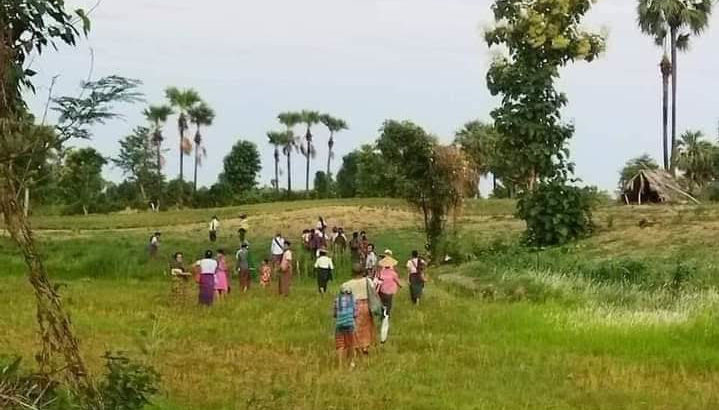
At Least 25 Civilians Killed in Shootout with Myanmar Junta
Villagers say regime forces used heavy artillery against civilians during offensives in Tabayin Township, Sagaing Region.
Around 41 civilians, including several children, were killed by Myanmar’s junta during a raid on villages in Tabayin (also known as Depayin) Township, Sagaing Region, on Friday.
The initial death toll from the attack has risen from 25 as more details of the violence emerge.
Villagers and the civilian resistance on Monday said 20 bodies had been identified, 15 civilians are injured and around 50 people are missing.
The shootouts broke out near Boke Ywar and Satpyarkyin villages when civilian resistance fighters used homemade firearms to repel hundreds of junta troops raiding villages on Friday morning.
During prolonged firefights, around six schoolchildren and five university students who resisted the troops were killed, according to a villager who was involved.
The villager said there were at least 15 military casualties.
Junta troops used numerous artillery rounds against civilian targets and reportedly opened fire on fleeing villagers.
“It was not a real shootout. It was one-sided as there is no strong People Defense Force in the area. Young villagers used homemade firearms in self-defense. They are not well-trained,” a resident told The Irrawaddy.
Villagers said the troops were firing on any civilian they saw. After being caught by junta troops, six wounded resistance fighters, left behind by retreating civilian combatants, were shot in the head by soldiers.
Other resistance fighters and villagers were shot dead by junta troops on Saturday when they returned to look for the dead and wounded.
Around 6,000 people from more than 10 Sagaing Region villages in Tabayin Township have fled their homes since last Friday.
Residents say the security forces are searching forests for villagers and shooting at any civilians they see.
A 50-year-old female Boke villager, who was sheltering in a forest, died on Monday after being bitten by a poisonous snake.
“Looting villagers’ homes and shooting at fleeing civilians are some of the military regime’s human rights violations,” a villager told The Irrawaddy.
In mid-June, Satpyarkyin saw a clash between the junta and resistance.
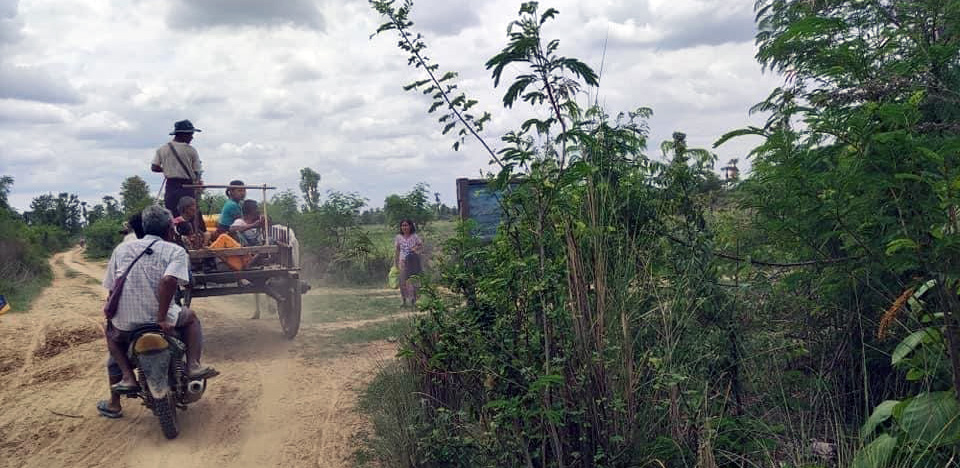
 www.irrawaddy.com
www.irrawaddy.com
The initial death toll from the attack has risen from 25 as more details of the violence emerge.
Villagers and the civilian resistance on Monday said 20 bodies had been identified, 15 civilians are injured and around 50 people are missing.
The shootouts broke out near Boke Ywar and Satpyarkyin villages when civilian resistance fighters used homemade firearms to repel hundreds of junta troops raiding villages on Friday morning.
During prolonged firefights, around six schoolchildren and five university students who resisted the troops were killed, according to a villager who was involved.
The villager said there were at least 15 military casualties.
Junta troops used numerous artillery rounds against civilian targets and reportedly opened fire on fleeing villagers.
“It was not a real shootout. It was one-sided as there is no strong People Defense Force in the area. Young villagers used homemade firearms in self-defense. They are not well-trained,” a resident told The Irrawaddy.
Villagers said the troops were firing on any civilian they saw. After being caught by junta troops, six wounded resistance fighters, left behind by retreating civilian combatants, were shot in the head by soldiers.
Other resistance fighters and villagers were shot dead by junta troops on Saturday when they returned to look for the dead and wounded.
Around 6,000 people from more than 10 Sagaing Region villages in Tabayin Township have fled their homes since last Friday.
Residents say the security forces are searching forests for villagers and shooting at any civilians they see.
A 50-year-old female Boke villager, who was sheltering in a forest, died on Monday after being bitten by a poisonous snake.
“Looting villagers’ homes and shooting at fleeing civilians are some of the military regime’s human rights violations,” a villager told The Irrawaddy.
In mid-June, Satpyarkyin saw a clash between the junta and resistance.

Myanmar Civilian Death Toll Rises From Sagaing Fighting
Poorly armed villagers were no match for hundreds of attacking junta troops, say residents.
People’s Defence Force (PDF) fighters in Sagaing Region have said they teamed up with the Kachin Independence Army (KIA) to kill more than 180 junta troops during five days of fighting last week.
The coup regime bombarded a temporary base of the PDF/KIA alliance with jets while alliance fighters sank military boats with rocket launchers and blew up personnel trucks with landmines, a local branch of the PDF said in a statement on Friday.
The battle started last Monday in the neighbouring townships of Katha and Shwebu, which are near Sagaing’s border with Kachin State and sit along the Ayeyarwady river.
Alliance fighters say three from their side were killed while another three went missing in action. Despite inflicting severe casualties on the Tatmadaw, they say they were eventually forced to retreat because of airstrikes on Friday.
There were no casualties from the airstrikes, the Katha PDF said.
The PDF’s announcement said the alliance fended off assaults by Tatmadaw battalions 304 and 309 near Myohla village in Shwegu. The Katha PDF fought under the leadership of the fifth battalion the KIA’s Brigade 8, it added.
Ten Tatmadaw soldiers were killed by landmines on the first day of fighting, while the alliance killed another 60 when it fired RPGs at two military boats on the Kout Kwae waterway, which flows into the Ayeyarwady river in Shwegu, the statement said.
Then on Wednesday more than 30 soldiers, including an officer, died in four different landmine explosions, it added.
The battle intensified on Friday when Tatmadaw reinforcements arrived by land and air, the statement said, but the alliance held off the assault, killing around 50 soldiers and injuring 70 others.
Another 30 soldiers died the same day in mine attacks on two vehicles carrying reinforcements near Paw Ma Myaing village in Katha, it said.
A resident from the area told Myanmar Now they heard about 20 explosions during the Paw Ma Myaing battle as well as the sound of machine gun fire.
The vehicles may have been carrying reinforcements to Shwegu and Myohla after shooting battles there the day before, the resident said.
There was also a battle on Saturday morning, though there were no further details available at the time of reporting.
A local living close to the PDF/KIA base said an airstrike destroyed a phone tower in Myohla during the fighting.
“MPT was the only telecoms service provider available in Myohla and because that has been destroyed, no landline telephones are working anymore,” the local said. “It was an air raid by the military. We don’t know for sure if they targeted the tower or if it was just collateral damage.”
“Because the air raid included four jets, the alliance forces were forced to retreat from Myohla just this morning,” the local said on Saturday.
The Tatamdaw buried its dead at the Moe Tar Gyi and Moe Tar Lay village tracts, near the villages of Oak Chay, Myohla, Mat Tine, Namsang and Subote Kone while the injured were taken away on boats, it added.
The KIA has not commented on the PDF’s announcement, and its information officer, Colonel Naw Bu, could not be reached for comment.
After PDF forces killed dozens of Tatmadaw soldiers in Sagaing last month, there were reports that the KIA had assisted the resistance fighters. At the time, Naw Bu told Myanmar Now that the KIA’s leadership had given no official order to support PDF fighters in Sagaing, but that it was possible lower ranking troops decided to help.
After vowing to oppose the military junta in the wake of its February coup, the KIA has launched numerous offensives against Tatmadaw bases and other targets in Kachin and Shan states.
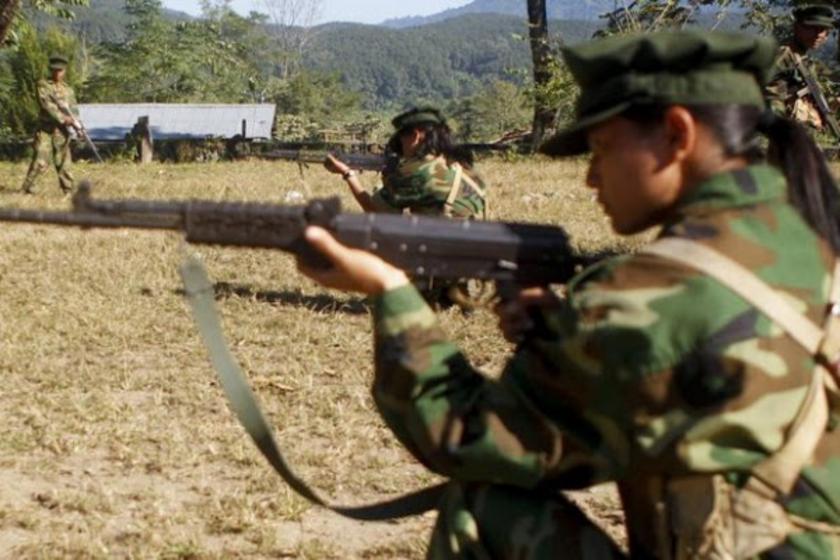
 www.myanmar-now.org
www.myanmar-now.org
The coup regime bombarded a temporary base of the PDF/KIA alliance with jets while alliance fighters sank military boats with rocket launchers and blew up personnel trucks with landmines, a local branch of the PDF said in a statement on Friday.
The battle started last Monday in the neighbouring townships of Katha and Shwebu, which are near Sagaing’s border with Kachin State and sit along the Ayeyarwady river.
Alliance fighters say three from their side were killed while another three went missing in action. Despite inflicting severe casualties on the Tatmadaw, they say they were eventually forced to retreat because of airstrikes on Friday.
There were no casualties from the airstrikes, the Katha PDF said.
The PDF’s announcement said the alliance fended off assaults by Tatmadaw battalions 304 and 309 near Myohla village in Shwegu. The Katha PDF fought under the leadership of the fifth battalion the KIA’s Brigade 8, it added.
Ten Tatmadaw soldiers were killed by landmines on the first day of fighting, while the alliance killed another 60 when it fired RPGs at two military boats on the Kout Kwae waterway, which flows into the Ayeyarwady river in Shwegu, the statement said.
Then on Wednesday more than 30 soldiers, including an officer, died in four different landmine explosions, it added.
The battle intensified on Friday when Tatmadaw reinforcements arrived by land and air, the statement said, but the alliance held off the assault, killing around 50 soldiers and injuring 70 others.
Another 30 soldiers died the same day in mine attacks on two vehicles carrying reinforcements near Paw Ma Myaing village in Katha, it said.
A resident from the area told Myanmar Now they heard about 20 explosions during the Paw Ma Myaing battle as well as the sound of machine gun fire.
The vehicles may have been carrying reinforcements to Shwegu and Myohla after shooting battles there the day before, the resident said.
There was also a battle on Saturday morning, though there were no further details available at the time of reporting.
A local living close to the PDF/KIA base said an airstrike destroyed a phone tower in Myohla during the fighting.
“MPT was the only telecoms service provider available in Myohla and because that has been destroyed, no landline telephones are working anymore,” the local said. “It was an air raid by the military. We don’t know for sure if they targeted the tower or if it was just collateral damage.”
“Because the air raid included four jets, the alliance forces were forced to retreat from Myohla just this morning,” the local said on Saturday.
The Tatamdaw buried its dead at the Moe Tar Gyi and Moe Tar Lay village tracts, near the villages of Oak Chay, Myohla, Mat Tine, Namsang and Subote Kone while the injured were taken away on boats, it added.
The KIA has not commented on the PDF’s announcement, and its information officer, Colonel Naw Bu, could not be reached for comment.
After PDF forces killed dozens of Tatmadaw soldiers in Sagaing last month, there were reports that the KIA had assisted the resistance fighters. At the time, Naw Bu told Myanmar Now that the KIA’s leadership had given no official order to support PDF fighters in Sagaing, but that it was possible lower ranking troops decided to help.
After vowing to oppose the military junta in the wake of its February coup, the KIA has launched numerous offensives against Tatmadaw bases and other targets in Kachin and Shan states.

People’s Defence Force in Sagaing says it killed 180 junta troops with help of Kachin Independence Army
The PDF/KIA alliance say three of their soldiers were killed and another three went missing in action during last week’s battle
Some 65 Myanmar army soldiers were killed and 101 injured in clashes with the Karen National Liberation Army (KNLA) in Karen State’s Mutraw (Hpapun) District in the month of July alone, according to the Karen National Union (KNU).
Thoolei News, under the KNU’s information department, posted on their Facebook page on Monday that a total of 133 battles were fought in the area last month, those injured included a junta battalion commander.
The commander was wounded during one of the 29 battles fought during the third week of July, the news outlet said.
In the fighting, five homes belonging to villagers were reportedly destroyed. The KNU also reported that the military council was responsible for 25 episodes of artillery fire in civilian areas. Four civilians also triggered landmine explosions.
Citing Col Saw Kler Doh—spokesperson for the KNLA’s Brigade 5, the territory of which is in Mutraw—Thoolei News said that two personnel from the military-allied Border Guard Force surrendered to the KNLA in July, and four light arms were confiscated at that time.
Three KNLA soldiers were also reportedly injured.
The news report stated that the occupying junta troops had stolen livestock from locals, including buffaloes and cows.
At the time of reporting, the military council had not responded to the KNU’s allegations.
Shelling by the junta’s LIB 409 in Thaton District—the KNLA’s Brigade 1 territory—also injured a local from Nyaung Kone village during the period in question, Thoolei News stated.
In addition to fighting with the KNLA, the military council’s armed forces have been engaged in battles with the Kachin Independence Army in Kachin and northern Shan states. The Karenni Army in Kayah (Karenni) State and the Chin National Front in Chin State have also fought alongside other local resistance forces against the junta.
The junta announced on July 31 that it would cease all “military activities” for two months, throughout August and September, but People’s Defence Forces and ethnic armed organisations have questioned the sincerity of the announcement. The Myanmar military has long been known to declare temporary unilateral ceasefires in its fights against ethnic armed organisations, then repeatedly break them.
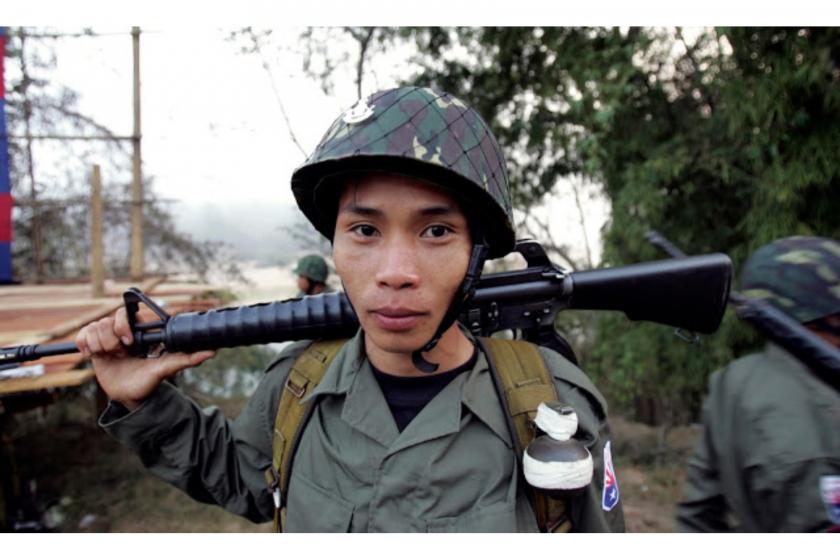
 www.myanmar-now.org
www.myanmar-now.org
An estimated 14 junta soldiers were reportedly killed in shootouts with the Karenni Army (KA) and Karenni Nationalities Defense Force (KNDF) in Kayah State this week.
On Wednesday afternoon, civilian resistance fighters and troops from the KNDF and KA, the armed wing of the Karenni National Progressive Party, ambushed around 120 troops from the 66th Division in the west of Demoso Township.
The KNDF said junta troops were preparing raids in Hpruso Township.
Three junta soldiers were killed and others injured while no casualties were reported by the ethnic armed groups.
Villagers have fled their homes because of the clashes, according to the KNDF.
Four shootouts between junta forces and the combined KA and KNDF occurred in Hpruso and Bawlakhe townships on Tuesday.
The heaviest fighting took place near Htar Lal village in Hpruso Township when the KA and KNDF ambushed around 27 military trucks carrying soldiers.
Three vehicles burned after triggering landmines.
At least 11 junta soldiers were killed and at least 20 injured, the KNDF said.
The Irrawaddy could not independently confirm the military casualties.
The KNDF said troops tortured villagers and looted Nan Hpe village in Bawlakhe Township after being attacked by Karenni forces in the township.
The regime is attacking Karenni forces in Loikaw, Demoso, Hpruso, Bawlakhe and Hpasawng townships.
The regime have carried out airstrikes against civilian targets after suffering heavy losses in the state. More than 100,000 Kayah residents were displaced in June by the fighting.
“We will not allow the military into Karenni Army-controlled areas. We will fight to force the troops out,” a KA representative told The Irrawaddy on Thursday.
Armed resistance against the junta started in Kayah State in late May.
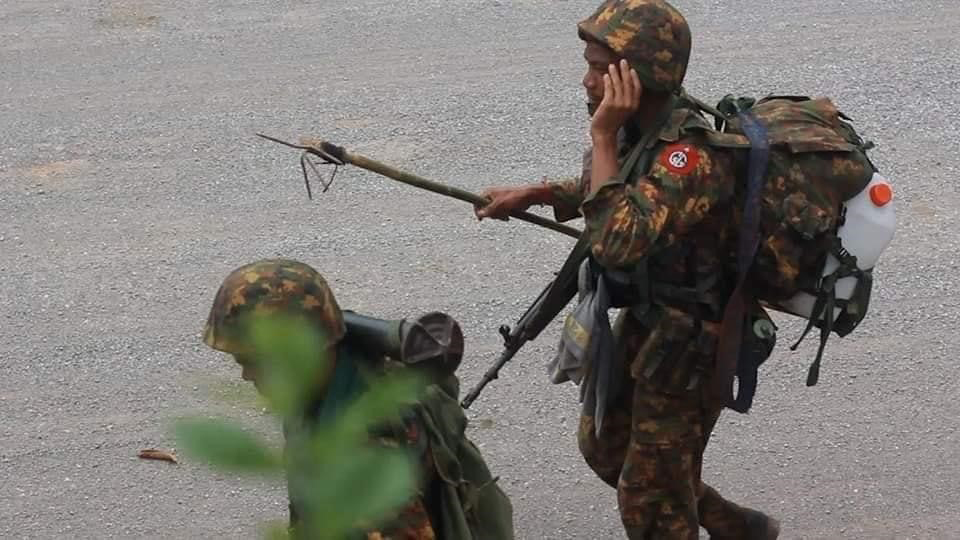
 www.irrawaddy.com
www.irrawaddy.com
Almost 60 civilian resistance People Defense Force (PDF) fighters in Mingin were detained while they tried to attack a Sagaing Region village on Wednesday.
At about 5am on Wednesday, civilian resistance fighters attacked Pan Set and Taungbyu villages, which are strongholds of Pyu-Saw-Htee military allies who are armed with automatic rifles by the junta, according to the PDF.
According to residents, junta troops and Pyu-Saw-Htee raided have villages and attacked the resistance in the township over the past month.
A resistance fighter in Mingin told The Irrawaddy on Thursday they attacked villages on Wednesday to prevent junta attacks with the Phyu-Saw-Htee on villages in the south of the township.
During the firefight at Taungbyu village, the 57 resistance members were seized by the Pyu-Saw-Htee, according to the PDF.
“Our fighters were detained by a trap after entering the village as the Pyu-Saw-Htee said they would surrender,” said a member of the PDF. Another 12 resistance fighters outside the village escaped.
The resistance fighters trying to save the detainees were forced to retreat by junta reinforcements. After the firefight, the military regime used a helicopter to supply ammunition, residents said.
“We have learned our members were detained at the Taungbyu village and some of them were slain,” said the PDF member.
The Irrawaddy was unable to independently confirm the killing of PDF detainees.

U Maung Myint, a former lawmaker for Mingin Township who is a central executive committee member of the military-backed Union Solidarity and Development Party (USDP), posted on Facebook on Wednesday that the PDF members were captured because of military tactics.
The former military officer said one villager was killed and three injured during fighting in Pan Set village.
During the firefight, five resistance fighters were injured, according to the PDF.
Also on Thursday, troops and Pyu-Saw-Htee members raided Konyin village and tortured villagers, a PDF member said.
Residents of three villages nearby have fled their homes to avoid junta raids.
Clashes between the resistance and junta in Mingin Township began in June.
More than 10,000 residents from Twin, Linponeyi and Zee Pin Twin villages in Kani Township, Sagaing Region, have fled their homes due to junta raids. The bodies of 12 villagers buried by junta troops on Monday were found near Zee Pin Twin on Tuesday, according to residents.
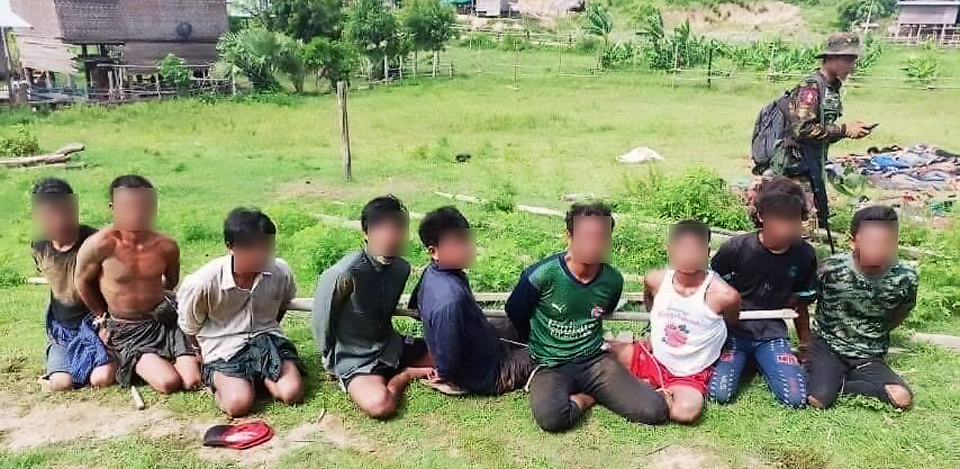
 www.irrawaddy.com
www.irrawaddy.com
The Kachin Independence Army (KIA) attacked two Myanmar military bases in northern Shan State early Thursday afternoon, the organisation’s spokesperson said.
KIA information officer Col Naw Bu told Myanmar Now that the Kachin forces fired heavy artillery at the junta’s military posts near two bridges: Nam Hkaing on the Union highway between Kutkai and Namphetka and Nam Paw, between Namphetka and Muse.
He added that the number of casualties was not yet confirmed.
"Fighting has broken out in many places these days. Fighting also broke out in the Mong Ko area,” Col Naw Bu said, referring to the town in Muse Township on the Shan-China border.
Nam Hkaing bridge is around 10 miles north of Kutkai and is a connecting point on the Lashio-Muse section of the Union highway.
A woman staying in the Hokho internally displaced persons camp in Mong Yu Lay village near Nam Hkaing bridge said she heard the sound of artillery shells being fired for around one hour, beginning at 11am.
"Because it was so close to us, we could hear the explosions. Out of fear, we did not dare to go out to see what was happening,” she said.
The junta’s military base near Kutkai town fired artillery shells back towards a base belonging to the KIA’s Battalion 9 under Brigade 6. Other Kutkai-based Myanmar military units joined the shelling, according to a Kutkai resident.
The fighting took place in an area where the KIA’s ninth battalion is active. There have been frequent clashes between the KIA and the junta’s army along the Lashio-Muse highway.
Mong Ko has also seen frequent bouts of fighting between the ethnic Kokang Myanmar National Democratic Alliance Army and the Myanmar military.
Since the February 1 military coup, heavy fighting has taken place between the KIA and the junta’s armed forces in northern Shan State and in neighbouring Kachin State.
The KIA, in cooperation with local People’s Defence Forces, has also fought the junta’s troops in Kawlin, Katha and Htigyaing townships in upper Sagaing Region.
On Monday afternoon, the KIA intercepted and attacked seven naval vessels belonging to the junta on the Irrawaddy River near Shwegu in Kachin State.
Prior to the coup, the KIA was not among the ethnic armed organisations signatory to the Nationwide Ceasefire Agreement with the government and military, but had engaged in preliminary peace talks with the National League for Democracy administration.
In February, following the military’s attempted seizure of power in Myanmar, the KIA announced that they would protect anti-coup protesters in Kachin State and welcomed the resistance movement.

 www.myanmar-now.org
www.myanmar-now.org
Six members of the junta’s forces surrendered to fighters from the Chinland Defence Force (CDF) on Saturday and joined the anti-coup resistance during a raid on a police station in Mindat Township, Chin State.
The CDF said they were able to capture the police station in the small, remote town of M’kuiimnu without firing a shot and that three soldiers, including a captain, and three police officers agreed to join the Civil Disobedience Movement (CDM).
“They just asked them if they wanted to fight or if they would take part in the CDM,” a man who is close to the Mindat branch of the CDF told Myanmar Now. “We’re lucky that all of them were already leaning towards joining the CDM. Everything was sorted out without even needing to use guns.”
The CDF fighters seized 22 guns including rifles and pistols, as well as rounds of ammunition, a spokesperson for the group said.
Captain Thein Hteik was among the soldiers who agreed to collaborate with the CDF, the spokesperson said, though he did not give further details about what that would entail.
There were previously around 20 troops stationed at the police station, but most had already defected and left their posts, according to the CDF spokesperson.
“This is a battle for every Myanmar civilian,” the spokesperson said. “Because this is a matter of the people, if you are truly a people’s soldier or a people’s police officer, I suggest you join us as soon as you can.”

Captain Tun Myat Aung, who defected from the military’s 77th Light Infantry Division in March, urged other soldiers to defect and collaborate with local People’s Defence Forces.
“Mindat is leading the revolution,” he told Myanmar Now. “Mindat was the first place to engage in armed struggle against the military council. I would like to urge other military bases to join the CDM so that we have more reinforcements.”
The military council has not commented on the CDF’s occupation of M'kuiimnu police station. A junta spokesperson did not answer calls seeking comment.
A weeks-long ceasefire between the CDF and the military ended on July 21. At least six CDF fighters have since been killed in clashes.
“We’ve been fighting while waiting for the NUG’s signal for an all-out war,” said the CDF spokesperson, referring to the underground National Unity Government. “The whole country is struggling to overthrow this 70-year-long dictatorship.”
Between April 24 and June 8 there were more than 20 clashes in Mindat, resulting in the destruction of six military vehicles. The CDF killed over 200 junta soldiers and lost 24 of its own fighters in that time, the Mindat People’s Administration Team said last week.
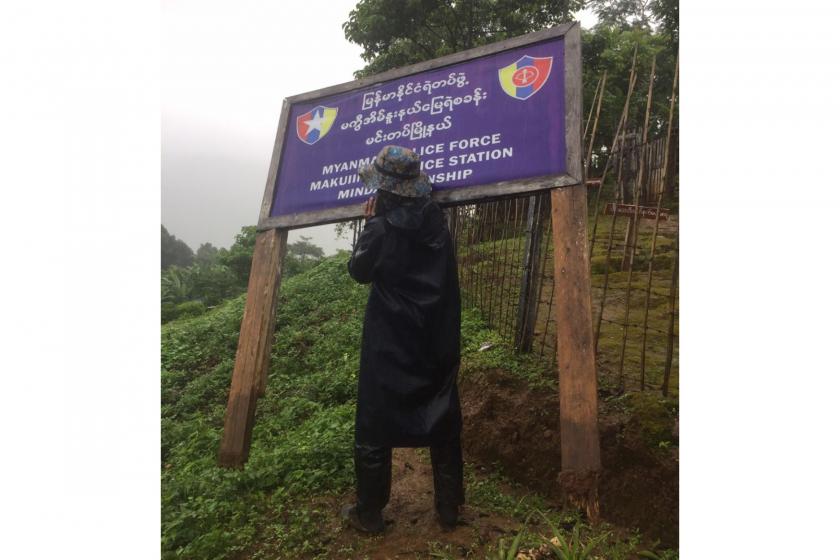
 www.myanmar-now.org
www.myanmar-now.org
Seven naval vessels carrying troops and weapons up the Ayeyarwady River were fired on by the Kachin Independence Army (KIA) near the town of Shwegu on Monday afternoon, according to a KIA spokesperson.
The attack on the naval convoy began near the village of Shwebonthar, about three miles from Shwegu, KIA information officer Col. Nawbu told Myanmar Now.
“They seem to be planning something, sending reinforcements like this. I heard there were also tanks. We’re still monitoring the situation,” he said.
He added that local People’s Defence Force (KIA) troops fought alongside the KIA during the clashes.
“We occasionally collaborate with the PDF, though it’s not something that was arranged or ordered by our central command,” he said.
The joint force managed to inflict some damage, but there were no reports of casualties, and the convoy was able to continue its journey, which it began in Mandalay three days earlier.
According to Kachin Wave, a local news outlet, one of the vessels was hit by a rocket-propelled grenade (RPG) but was not disabled by the attack.
“The ship that got hit didn’t sink. [The RPG] did some damage, though,” the outlet quoted a source as saying.
Troops aboard the vessels also fired back at their attackers, Kachin Wave reported.
Clashes have been breaking out between the military and the KIA in Kachin State since April, as the junta continues to send weapons and reinforcements into the conflict zone, often by military or civilian river vessels.
Despite the build-up, there has been little evidence of movement among troops based in the area, according to Col. Nawbu. The clashes on Monday came after a week without any major engagements, he said.
However, Kachinnet Burmese, which is run by the KIA’s news and information department, has reported some shelling over the past few days.
It said that the military fired a number of times last Friday at bases operated by the KIA’s brigades 3 and 15. That came after junta troops stepped on landmines in KIA Brigade 5 territory earlier that day, Col. Nawbu explained.
There has also been fighting between the military and the Myanmar National Democratic Alliance Army, also known as the Kokang Army, in the Mong Ko (Mankan) area of northern Shan State, where KIA Brigade 6 is also active.
Anti-junta resistance forces in Chin State say they are expecting intense clashes in the conflict-hit township of Mindat after their fighters killed a Tatmadaw battalion commander last week.
A spokesperson for the Chinland Defence Force (CDF) said the commander, a lieutenant colonel, died during a clash along the Mindat-Matupi highway early on Friday morning.
Military-controlled newspaper The Mirror announced on Saturday that lieutenant colonel Zaw Zaw Soe, 48, died at around 6.15am while on duty, though it did not give details of where or how he died.
Zaw Zaw Soe was among 10 junta soldiers killed in Friday’s battle, according to the CDF. Since that clash, the situation in Mindat has become more tense, the group’s spokesperson said.
“The military has been sending reinforcements. I think they’ve already sent around three columns of their troops,” he told Myanmar Now. “After the battle… around 80 reinforcement troops arrived from Matupi. It looks like the battle will become more serious.”
Fighting along the mountainous highway started on July 21 when the junta’s forces launched an attack, according to the Mindat People’s Administration Team.
Twenty six junta troops and 15 CDF fighters have died in the two weeks since then, the CDF spokesperson said. There are also unconfirmed reports that civilians have been forced to flee their homes.
On July 24, the CDF said it seized control of a police station in the remote town of M’kuiimnu without firing a shot after six police and soldiers surrendered and agreed to join the resistance.
Mindat has become a stronghold of armed resistance to the junta since civilians took up arms there in April, using traditional hunting rifles and later seizing more advanced weapons from the military.
During the latest clashes, the Chin National Front, an armed group that was largely inactive before the coup, has fought alongside the CDF, as have chapters of the People’s Defence Force from different areas of Chin State, the CDF spokesperson said.
The CDF says it plans to continue attacks even as it waits for the underground National Unity Government (NUG) to give the signal for full-scale nationwide attacks against junta forces, the spokesperson said.
“Right now, we’re planning to continue the battles as we prepare for the upcoming war. There’s no way to stop the battles if they’re going to keep trespassing on the areas we are operating in,” he said.
The NUG's defence minister Yee Mon told RFA last month that about 8,000 PDF fighters will finish combat training by the end of July. He urged resistance fighters across the country to wait for its signal to launch a coordinated offensive.
“During this preparation period, I urge our revolution comrades to prepare for their own individual safety, health and morale,” Yee Mon told the broadcaster.
Last month a spokesperson for the eastern Yangon chapter of the PDF, which has been coordinating closely with the NUG, told Myanmar Now that an “all-out” conflict was on its way.
“I promise we will arrive at your door very soon,” he said. “We are currently engaging in guerrilla warfare, but please know that it won’t be long before we begin an all-out battle.”
A dozen bodies were discovered near a village in Sagaing Region’s Kani Township on Friday, offering further evidence of atrocity killings by regime forces operating in the area.
The 12 bodies, including one of a 14-year-old boy, were found in a wooded area near the village of Taung Pauk on the afternoon of July 30, local sources said.
Days earlier, military forces entered Taung Pauk and other nearby villages and began arresting male residents suspected of involvement in the anti-coup resistance movement.
A search party was later formed to locate the detained villagers, all of whom appear to have been tortured and murdered on the day of their arrest.
“The bodies were very badly bruised. They had also started to decompose, to the point that you couldn’t pick them up. They were killed on the 26th or 27th, so that was understandable,” said a local activist who spoke to members of the search party.
Some of the bodies had been kept under a burned hut and were covered by a sheet, he added.
All 12 of the victims have been identified as villagers who were in the custody of the military at the time of their death.
Two were from the village of Kho Twin and seven—including the 14-year-old—were from Thayet Taw, another village in the area. The other three were residents of the town of Kani who were staying with relatives in Thayet Taw.
None of the bodies have been taken away for burial because the military is still active in the area, local residents told Myanmar Now.
This is the third time in less than a month that bodies have been found dumped near villages in Kani Township. A total of at least 40 have been discovered so far, most of them showing signs of torture.
On July 11 and 12, the bodies of 15 people were found scattered in a forest near Yin, a village that had been raided along with several others the day before.
At least 13 more bodies were discovered last week near the village of Zee Pin Twin following clashes between the military and the local People’s Defence Force (PDF).
The mass killings appear to be aimed at weakening support for the resistance movement, according to PDF fighters who insist that the regime’s brutal tactics are backfiring.
“People are joining us now to avenge their dead loved ones, even if they didn’t want to fight before. The military’s attempt to terrify people into submission doesn’t work anymore,” said one PDF member who didn’t want to be named.
Meanwhile, thousands of villagers have been displaced since the second week of July as clashes in Kani continue.
Most have been forced to seek refuge in forested areas due to fears that crowding into camps or other villages could lead to dangerous levels of exposure to Covid-19 amid a recent surge of the disease.
“We can’t make camps because of the pandemic. But we don’t have suitable shelter in the forest, which we need because it has been raining a lot. Aside from Covid-19, seasonal flu has been pretty bad,” said one displaced villager.
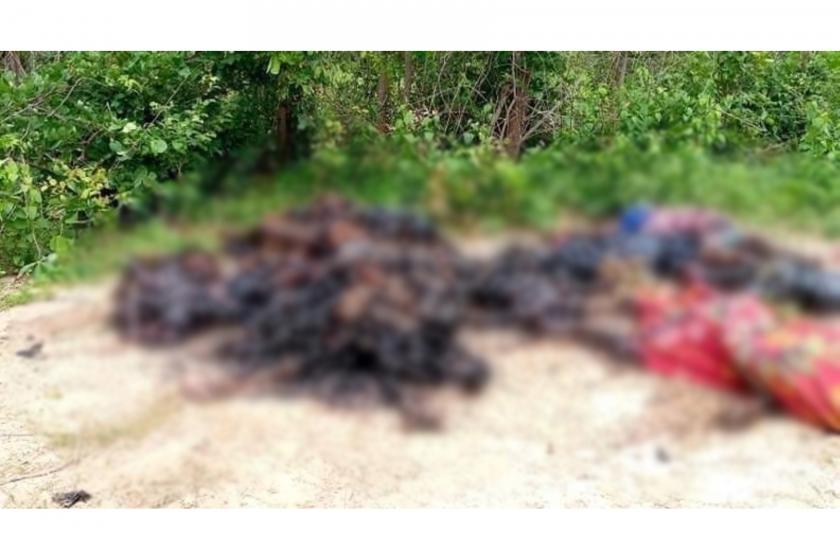
 www.myanmar-now.org
www.myanmar-now.org
Thoolei News, under the KNU’s information department, posted on their Facebook page on Monday that a total of 133 battles were fought in the area last month, those injured included a junta battalion commander.
The commander was wounded during one of the 29 battles fought during the third week of July, the news outlet said.
In the fighting, five homes belonging to villagers were reportedly destroyed. The KNU also reported that the military council was responsible for 25 episodes of artillery fire in civilian areas. Four civilians also triggered landmine explosions.
Citing Col Saw Kler Doh—spokesperson for the KNLA’s Brigade 5, the territory of which is in Mutraw—Thoolei News said that two personnel from the military-allied Border Guard Force surrendered to the KNLA in July, and four light arms were confiscated at that time.
Three KNLA soldiers were also reportedly injured.
The news report stated that the occupying junta troops had stolen livestock from locals, including buffaloes and cows.
At the time of reporting, the military council had not responded to the KNU’s allegations.
Shelling by the junta’s LIB 409 in Thaton District—the KNLA’s Brigade 1 territory—also injured a local from Nyaung Kone village during the period in question, Thoolei News stated.
In addition to fighting with the KNLA, the military council’s armed forces have been engaged in battles with the Kachin Independence Army in Kachin and northern Shan states. The Karenni Army in Kayah (Karenni) State and the Chin National Front in Chin State have also fought alongside other local resistance forces against the junta.
The junta announced on July 31 that it would cease all “military activities” for two months, throughout August and September, but People’s Defence Forces and ethnic armed organisations have questioned the sincerity of the announcement. The Myanmar military has long been known to declare temporary unilateral ceasefires in its fights against ethnic armed organisations, then repeatedly break them.

More than 60 junta troops killed in Mutraw in July, KNU says
In just one month, the KNLA’s Brigade 5 reports fighting more than 130 battles with the junta’s army
An estimated 14 junta soldiers were reportedly killed in shootouts with the Karenni Army (KA) and Karenni Nationalities Defense Force (KNDF) in Kayah State this week.
On Wednesday afternoon, civilian resistance fighters and troops from the KNDF and KA, the armed wing of the Karenni National Progressive Party, ambushed around 120 troops from the 66th Division in the west of Demoso Township.
The KNDF said junta troops were preparing raids in Hpruso Township.
Three junta soldiers were killed and others injured while no casualties were reported by the ethnic armed groups.
Villagers have fled their homes because of the clashes, according to the KNDF.
Four shootouts between junta forces and the combined KA and KNDF occurred in Hpruso and Bawlakhe townships on Tuesday.
The heaviest fighting took place near Htar Lal village in Hpruso Township when the KA and KNDF ambushed around 27 military trucks carrying soldiers.
Three vehicles burned after triggering landmines.
At least 11 junta soldiers were killed and at least 20 injured, the KNDF said.
The Irrawaddy could not independently confirm the military casualties.
The KNDF said troops tortured villagers and looted Nan Hpe village in Bawlakhe Township after being attacked by Karenni forces in the township.
The regime is attacking Karenni forces in Loikaw, Demoso, Hpruso, Bawlakhe and Hpasawng townships.
The regime have carried out airstrikes against civilian targets after suffering heavy losses in the state. More than 100,000 Kayah residents were displaced in June by the fighting.
“We will not allow the military into Karenni Army-controlled areas. We will fight to force the troops out,” a KA representative told The Irrawaddy on Thursday.
Armed resistance against the junta started in Kayah State in late May.

Kayah Forces Claim Successful Attacks on Myanmar Junta Troops
The Karenni Army and Karenni Nationalities Defense Force say they have killed at least 14 regime soldiers in ambushes across the state.
Almost 60 civilian resistance People Defense Force (PDF) fighters in Mingin were detained while they tried to attack a Sagaing Region village on Wednesday.
At about 5am on Wednesday, civilian resistance fighters attacked Pan Set and Taungbyu villages, which are strongholds of Pyu-Saw-Htee military allies who are armed with automatic rifles by the junta, according to the PDF.
According to residents, junta troops and Pyu-Saw-Htee raided have villages and attacked the resistance in the township over the past month.
A resistance fighter in Mingin told The Irrawaddy on Thursday they attacked villages on Wednesday to prevent junta attacks with the Phyu-Saw-Htee on villages in the south of the township.
During the firefight at Taungbyu village, the 57 resistance members were seized by the Pyu-Saw-Htee, according to the PDF.
“Our fighters were detained by a trap after entering the village as the Pyu-Saw-Htee said they would surrender,” said a member of the PDF. Another 12 resistance fighters outside the village escaped.
The resistance fighters trying to save the detainees were forced to retreat by junta reinforcements. After the firefight, the military regime used a helicopter to supply ammunition, residents said.
“We have learned our members were detained at the Taungbyu village and some of them were slain,” said the PDF member.
The Irrawaddy was unable to independently confirm the killing of PDF detainees.
U Maung Myint, a former lawmaker for Mingin Township who is a central executive committee member of the military-backed Union Solidarity and Development Party (USDP), posted on Facebook on Wednesday that the PDF members were captured because of military tactics.
The former military officer said one villager was killed and three injured during fighting in Pan Set village.
During the firefight, five resistance fighters were injured, according to the PDF.
Also on Thursday, troops and Pyu-Saw-Htee members raided Konyin village and tortured villagers, a PDF member said.
Residents of three villages nearby have fled their homes to avoid junta raids.
Clashes between the resistance and junta in Mingin Township began in June.
More than 10,000 residents from Twin, Linponeyi and Zee Pin Twin villages in Kani Township, Sagaing Region, have fled their homes due to junta raids. The bodies of 12 villagers buried by junta troops on Monday were found near Zee Pin Twin on Tuesday, according to residents.

Dozens of Myanmar Resistance Fighters Seized in Sagaing Region
“Our fighters were detained by a trap after entering the village as the Pyu-Saw-Htee said they would surrender,” said a resistance fighter.
The Kachin Independence Army (KIA) attacked two Myanmar military bases in northern Shan State early Thursday afternoon, the organisation’s spokesperson said.
KIA information officer Col Naw Bu told Myanmar Now that the Kachin forces fired heavy artillery at the junta’s military posts near two bridges: Nam Hkaing on the Union highway between Kutkai and Namphetka and Nam Paw, between Namphetka and Muse.
He added that the number of casualties was not yet confirmed.
"Fighting has broken out in many places these days. Fighting also broke out in the Mong Ko area,” Col Naw Bu said, referring to the town in Muse Township on the Shan-China border.
Nam Hkaing bridge is around 10 miles north of Kutkai and is a connecting point on the Lashio-Muse section of the Union highway.
A woman staying in the Hokho internally displaced persons camp in Mong Yu Lay village near Nam Hkaing bridge said she heard the sound of artillery shells being fired for around one hour, beginning at 11am.
"Because it was so close to us, we could hear the explosions. Out of fear, we did not dare to go out to see what was happening,” she said.
The junta’s military base near Kutkai town fired artillery shells back towards a base belonging to the KIA’s Battalion 9 under Brigade 6. Other Kutkai-based Myanmar military units joined the shelling, according to a Kutkai resident.
The fighting took place in an area where the KIA’s ninth battalion is active. There have been frequent clashes between the KIA and the junta’s army along the Lashio-Muse highway.
Mong Ko has also seen frequent bouts of fighting between the ethnic Kokang Myanmar National Democratic Alliance Army and the Myanmar military.
Since the February 1 military coup, heavy fighting has taken place between the KIA and the junta’s armed forces in northern Shan State and in neighbouring Kachin State.
The KIA, in cooperation with local People’s Defence Forces, has also fought the junta’s troops in Kawlin, Katha and Htigyaing townships in upper Sagaing Region.
On Monday afternoon, the KIA intercepted and attacked seven naval vessels belonging to the junta on the Irrawaddy River near Shwegu in Kachin State.
Prior to the coup, the KIA was not among the ethnic armed organisations signatory to the Nationwide Ceasefire Agreement with the government and military, but had engaged in preliminary peace talks with the National League for Democracy administration.
In February, following the military’s attempted seizure of power in Myanmar, the KIA announced that they would protect anti-coup protesters in Kachin State and welcomed the resistance movement.

KIA attacks two junta military bases in northern Shan State
The Kachin forces fired artillery at two military posts located near strategic bridges
Six members of the junta’s forces surrendered to fighters from the Chinland Defence Force (CDF) on Saturday and joined the anti-coup resistance during a raid on a police station in Mindat Township, Chin State.
The CDF said they were able to capture the police station in the small, remote town of M’kuiimnu without firing a shot and that three soldiers, including a captain, and three police officers agreed to join the Civil Disobedience Movement (CDM).
“They just asked them if they wanted to fight or if they would take part in the CDM,” a man who is close to the Mindat branch of the CDF told Myanmar Now. “We’re lucky that all of them were already leaning towards joining the CDM. Everything was sorted out without even needing to use guns.”
The CDF fighters seized 22 guns including rifles and pistols, as well as rounds of ammunition, a spokesperson for the group said.
Captain Thein Hteik was among the soldiers who agreed to collaborate with the CDF, the spokesperson said, though he did not give further details about what that would entail.
There were previously around 20 troops stationed at the police station, but most had already defected and left their posts, according to the CDF spokesperson.
“This is a battle for every Myanmar civilian,” the spokesperson said. “Because this is a matter of the people, if you are truly a people’s soldier or a people’s police officer, I suggest you join us as soon as you can.”
Captain Tun Myat Aung, who defected from the military’s 77th Light Infantry Division in March, urged other soldiers to defect and collaborate with local People’s Defence Forces.
“Mindat is leading the revolution,” he told Myanmar Now. “Mindat was the first place to engage in armed struggle against the military council. I would like to urge other military bases to join the CDM so that we have more reinforcements.”
The military council has not commented on the CDF’s occupation of M'kuiimnu police station. A junta spokesperson did not answer calls seeking comment.
A weeks-long ceasefire between the CDF and the military ended on July 21. At least six CDF fighters have since been killed in clashes.
“We’ve been fighting while waiting for the NUG’s signal for an all-out war,” said the CDF spokesperson, referring to the underground National Unity Government. “The whole country is struggling to overthrow this 70-year-long dictatorship.”
Between April 24 and June 8 there were more than 20 clashes in Mindat, resulting in the destruction of six military vehicles. The CDF killed over 200 junta soldiers and lost 24 of its own fighters in that time, the Mindat People’s Administration Team said last week.

Six police and soldiers join resistance fighters in Chin after surrendering during raid
The Chinland Defence Force captured a police station in Mindat without firing a single shot
Seven naval vessels carrying troops and weapons up the Ayeyarwady River were fired on by the Kachin Independence Army (KIA) near the town of Shwegu on Monday afternoon, according to a KIA spokesperson.
The attack on the naval convoy began near the village of Shwebonthar, about three miles from Shwegu, KIA information officer Col. Nawbu told Myanmar Now.
“They seem to be planning something, sending reinforcements like this. I heard there were also tanks. We’re still monitoring the situation,” he said.
He added that local People’s Defence Force (KIA) troops fought alongside the KIA during the clashes.
“We occasionally collaborate with the PDF, though it’s not something that was arranged or ordered by our central command,” he said.
The joint force managed to inflict some damage, but there were no reports of casualties, and the convoy was able to continue its journey, which it began in Mandalay three days earlier.
According to Kachin Wave, a local news outlet, one of the vessels was hit by a rocket-propelled grenade (RPG) but was not disabled by the attack.
“The ship that got hit didn’t sink. [The RPG] did some damage, though,” the outlet quoted a source as saying.
Troops aboard the vessels also fired back at their attackers, Kachin Wave reported.
Clashes have been breaking out between the military and the KIA in Kachin State since April, as the junta continues to send weapons and reinforcements into the conflict zone, often by military or civilian river vessels.
Despite the build-up, there has been little evidence of movement among troops based in the area, according to Col. Nawbu. The clashes on Monday came after a week without any major engagements, he said.
However, Kachinnet Burmese, which is run by the KIA’s news and information department, has reported some shelling over the past few days.
It said that the military fired a number of times last Friday at bases operated by the KIA’s brigades 3 and 15. That came after junta troops stepped on landmines in KIA Brigade 5 territory earlier that day, Col. Nawbu explained.
There has also been fighting between the military and the Myanmar National Democratic Alliance Army, also known as the Kokang Army, in the Mong Ko (Mankan) area of northern Shan State, where KIA Brigade 6 is also active.
Anti-junta resistance forces in Chin State say they are expecting intense clashes in the conflict-hit township of Mindat after their fighters killed a Tatmadaw battalion commander last week.
A spokesperson for the Chinland Defence Force (CDF) said the commander, a lieutenant colonel, died during a clash along the Mindat-Matupi highway early on Friday morning.
Military-controlled newspaper The Mirror announced on Saturday that lieutenant colonel Zaw Zaw Soe, 48, died at around 6.15am while on duty, though it did not give details of where or how he died.
Zaw Zaw Soe was among 10 junta soldiers killed in Friday’s battle, according to the CDF. Since that clash, the situation in Mindat has become more tense, the group’s spokesperson said.
“The military has been sending reinforcements. I think they’ve already sent around three columns of their troops,” he told Myanmar Now. “After the battle… around 80 reinforcement troops arrived from Matupi. It looks like the battle will become more serious.”
Fighting along the mountainous highway started on July 21 when the junta’s forces launched an attack, according to the Mindat People’s Administration Team.
Twenty six junta troops and 15 CDF fighters have died in the two weeks since then, the CDF spokesperson said. There are also unconfirmed reports that civilians have been forced to flee their homes.
On July 24, the CDF said it seized control of a police station in the remote town of M’kuiimnu without firing a shot after six police and soldiers surrendered and agreed to join the resistance.
Mindat has become a stronghold of armed resistance to the junta since civilians took up arms there in April, using traditional hunting rifles and later seizing more advanced weapons from the military.
During the latest clashes, the Chin National Front, an armed group that was largely inactive before the coup, has fought alongside the CDF, as have chapters of the People’s Defence Force from different areas of Chin State, the CDF spokesperson said.
The CDF says it plans to continue attacks even as it waits for the underground National Unity Government (NUG) to give the signal for full-scale nationwide attacks against junta forces, the spokesperson said.
“Right now, we’re planning to continue the battles as we prepare for the upcoming war. There’s no way to stop the battles if they’re going to keep trespassing on the areas we are operating in,” he said.
The NUG's defence minister Yee Mon told RFA last month that about 8,000 PDF fighters will finish combat training by the end of July. He urged resistance fighters across the country to wait for its signal to launch a coordinated offensive.
“During this preparation period, I urge our revolution comrades to prepare for their own individual safety, health and morale,” Yee Mon told the broadcaster.
Last month a spokesperson for the eastern Yangon chapter of the PDF, which has been coordinating closely with the NUG, told Myanmar Now that an “all-out” conflict was on its way.
“I promise we will arrive at your door very soon,” he said. “We are currently engaging in guerrilla warfare, but please know that it won’t be long before we begin an all-out battle.”
A dozen bodies were discovered near a village in Sagaing Region’s Kani Township on Friday, offering further evidence of atrocity killings by regime forces operating in the area.
The 12 bodies, including one of a 14-year-old boy, were found in a wooded area near the village of Taung Pauk on the afternoon of July 30, local sources said.
Days earlier, military forces entered Taung Pauk and other nearby villages and began arresting male residents suspected of involvement in the anti-coup resistance movement.
A search party was later formed to locate the detained villagers, all of whom appear to have been tortured and murdered on the day of their arrest.
“The bodies were very badly bruised. They had also started to decompose, to the point that you couldn’t pick them up. They were killed on the 26th or 27th, so that was understandable,” said a local activist who spoke to members of the search party.
Some of the bodies had been kept under a burned hut and were covered by a sheet, he added.
All 12 of the victims have been identified as villagers who were in the custody of the military at the time of their death.
Two were from the village of Kho Twin and seven—including the 14-year-old—were from Thayet Taw, another village in the area. The other three were residents of the town of Kani who were staying with relatives in Thayet Taw.
None of the bodies have been taken away for burial because the military is still active in the area, local residents told Myanmar Now.
This is the third time in less than a month that bodies have been found dumped near villages in Kani Township. A total of at least 40 have been discovered so far, most of them showing signs of torture.
On July 11 and 12, the bodies of 15 people were found scattered in a forest near Yin, a village that had been raided along with several others the day before.
At least 13 more bodies were discovered last week near the village of Zee Pin Twin following clashes between the military and the local People’s Defence Force (PDF).
The mass killings appear to be aimed at weakening support for the resistance movement, according to PDF fighters who insist that the regime’s brutal tactics are backfiring.
“People are joining us now to avenge their dead loved ones, even if they didn’t want to fight before. The military’s attempt to terrify people into submission doesn’t work anymore,” said one PDF member who didn’t want to be named.
Meanwhile, thousands of villagers have been displaced since the second week of July as clashes in Kani continue.
Most have been forced to seek refuge in forested areas due to fears that crowding into camps or other villages could lead to dangerous levels of exposure to Covid-19 amid a recent surge of the disease.
“We can’t make camps because of the pandemic. But we don’t have suitable shelter in the forest, which we need because it has been raining a lot. Aside from Covid-19, seasonal flu has been pretty bad,” said one displaced villager.

Kani villagers find more bodies of civilians murdered by junta forces
A total of 40 corpses, most showing evidence of torture, have been discovered in the area over the past month
At least 10 military regime soldiers were reportedly killed and others wounded on Sunday in a shootout with ethnic armed groups the Karenni Army (KA) and the Karenni Nationalities Defense Force (KNDF) in Kayah State, southeastern Myanmar.
Civilian resistance fighters and troops from the KNDF and KA, the armed wing of the Karenni National Progressive Party, ambushed around 300 junta troops on Sunday morning near the border between Shan State’s Pekon Township and Kayah State’s Hpruso Township.
The KNDF said that the Myanmar military was trying to raid a mountainous area located to the west of Hpruso Township where people’s defense forces (PDF’s) and Karenni armed groups are based.
The firefight lasted about an hour, but junta troops continued firing heavy weapons for around four hours, a spokesperson for the KNDF told the Irrawaddy on Monday.
10 junta soldiers were reported killed and others were wounded, while a number of civilian resistance fighters suffered minor injuries from explosions.
Around 500 residents from three nearby villages fled their homes because of the clash.
Shootouts continued through the afternoon as the junta troops launched raids in the area, according to the KNDF’s statement.
The KNDF said also that several columns of regime soldiers are on the move in Kayah State and are preparing to attack PDF’s in Loikaw and Hpruso townships.
Last week, a series of firefights between junta troops and the KNDF and KA took place in three townships, Demoso, Hpruso and Bawlakhe, over the course of two days.
Around 14 junta soldiers were reportedly killed by the KA and KNDF during the clashes.
Armed resistance to military rule in Kayah State began in late May, following the regime’s brutal crackdowns on peaceful anti-coup demonstrations across the country.
The regime has carried out airstrikes against civilian targets after suffering heavy losses in Kayah State. The fighting in June forced over 100,000 local residents to flee their homes.
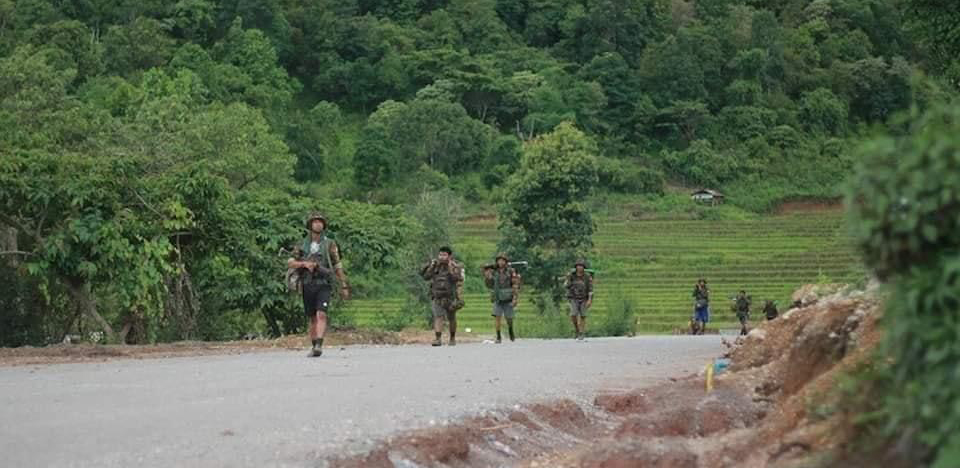
 www.irrawaddy.com
www.irrawaddy.com
More than 740 junta soldiers were killed and almost 370 wounded during 355 shootouts with the ethnic armed forces and civilian resistance fighters in July, according to Myanmar’s parallel National Unity Government (NUG).
Based on media reports, the NUG said almost 200 civilians were killed and 47 injured by the military in fighting during the month.
The regime has killed about 800 civilians during crackdowns, raids and random shootings.
Resistance fighters are using air guns, homemade firearms and bombs across the country, except in Rakhine State. That state reported only one explosion and an attack on a junta informant in July.
In July, junta forces faced 60 battles with ethnic armed forces and 62 shootouts with the civilian People’s Defense Forces.
There were 87 assassinations of junta troops and about 75 explosions.
The regime suffered the heaviest losses in Sagaing Region with 36 firefights with civilian resistance forces, three shootouts with ethnic armed forces and 36 assassinations of the troops, according to the NUG.
Junta troops committed 23 violent acts, including massacres, in the region.
It estimated that 417 junta soldiers were killed and 270 injured and 128 civilians were killed and six wounded in Sagaing Region.
In Kani Township in the region, around 40 civilians, including a child, were killed in a series of junta massacres during military operations against the civilian resistance.
A resident told The Irrawaddy on Monday that people would face shortages of food and drugs in Kani Township soon as troops had cut off all transport into the township.
Troops at the entrances of the township are detaining or threatening Kani residents who leave the township, the resident said.
The regime has cut access to the internet and other telecommunications in the township.
“They are committing war crimes, massacring civilians in our township,” the resident said. “They stop food and drugs, trade and access to the internet. It feels like genocide by the regime.”
People from 10 villages in Depayin Township in Sagaing Region have fled their homes due to military raids since Sunday. Heavy explosives were used on the villages and homes were ransacked, according to residents.
The NUG said Mandalay Region reported the second-largest amount of violence with 44 cases in July.
It reported 12 explosions, 18 attacks against junta troops and three shootouts, including two with the People Defense Force.
During the conflicts, three troops and 14 civilians were killed and 17 injured.
By Monday, more than 960 people have been killed by the regime during crackdowns, raids, arrests and random shootings, according to the Assistance Association for Political Prisoners that is documenting deaths and arrests since Feb. 1 coup.
More than 7,000 people, including elected government leaders, National League for Democracy members, protesters, activists, journalists, writers and artists, have also been detained by the junta.

 www.irrawaddy.com
www.irrawaddy.com
Civilian resistance fighters and troops from the KNDF and KA, the armed wing of the Karenni National Progressive Party, ambushed around 300 junta troops on Sunday morning near the border between Shan State’s Pekon Township and Kayah State’s Hpruso Township.
The KNDF said that the Myanmar military was trying to raid a mountainous area located to the west of Hpruso Township where people’s defense forces (PDF’s) and Karenni armed groups are based.
The firefight lasted about an hour, but junta troops continued firing heavy weapons for around four hours, a spokesperson for the KNDF told the Irrawaddy on Monday.
10 junta soldiers were reported killed and others were wounded, while a number of civilian resistance fighters suffered minor injuries from explosions.
Around 500 residents from three nearby villages fled their homes because of the clash.
Shootouts continued through the afternoon as the junta troops launched raids in the area, according to the KNDF’s statement.
The KNDF said also that several columns of regime soldiers are on the move in Kayah State and are preparing to attack PDF’s in Loikaw and Hpruso townships.
Last week, a series of firefights between junta troops and the KNDF and KA took place in three townships, Demoso, Hpruso and Bawlakhe, over the course of two days.
Around 14 junta soldiers were reportedly killed by the KA and KNDF during the clashes.
Armed resistance to military rule in Kayah State began in late May, following the regime’s brutal crackdowns on peaceful anti-coup demonstrations across the country.
The regime has carried out airstrikes against civilian targets after suffering heavy losses in Kayah State. The fighting in June forced over 100,000 local residents to flee their homes.

Myanmar Junta Troops Killed in Kayah State Firefight
10 regime soldiers died on Sunday after being ambushed by ethnic armed groups and civilian resistance fighters in southeastern Myanmar.
More than 740 junta soldiers were killed and almost 370 wounded during 355 shootouts with the ethnic armed forces and civilian resistance fighters in July, according to Myanmar’s parallel National Unity Government (NUG).
Based on media reports, the NUG said almost 200 civilians were killed and 47 injured by the military in fighting during the month.
The regime has killed about 800 civilians during crackdowns, raids and random shootings.
Resistance fighters are using air guns, homemade firearms and bombs across the country, except in Rakhine State. That state reported only one explosion and an attack on a junta informant in July.
In July, junta forces faced 60 battles with ethnic armed forces and 62 shootouts with the civilian People’s Defense Forces.
There were 87 assassinations of junta troops and about 75 explosions.
The regime suffered the heaviest losses in Sagaing Region with 36 firefights with civilian resistance forces, three shootouts with ethnic armed forces and 36 assassinations of the troops, according to the NUG.
Junta troops committed 23 violent acts, including massacres, in the region.
It estimated that 417 junta soldiers were killed and 270 injured and 128 civilians were killed and six wounded in Sagaing Region.
In Kani Township in the region, around 40 civilians, including a child, were killed in a series of junta massacres during military operations against the civilian resistance.
A resident told The Irrawaddy on Monday that people would face shortages of food and drugs in Kani Township soon as troops had cut off all transport into the township.
Troops at the entrances of the township are detaining or threatening Kani residents who leave the township, the resident said.
The regime has cut access to the internet and other telecommunications in the township.
“They are committing war crimes, massacring civilians in our township,” the resident said. “They stop food and drugs, trade and access to the internet. It feels like genocide by the regime.”
People from 10 villages in Depayin Township in Sagaing Region have fled their homes due to military raids since Sunday. Heavy explosives were used on the villages and homes were ransacked, according to residents.
The NUG said Mandalay Region reported the second-largest amount of violence with 44 cases in July.
It reported 12 explosions, 18 attacks against junta troops and three shootouts, including two with the People Defense Force.
During the conflicts, three troops and 14 civilians were killed and 17 injured.
By Monday, more than 960 people have been killed by the regime during crackdowns, raids, arrests and random shootings, according to the Assistance Association for Political Prisoners that is documenting deaths and arrests since Feb. 1 coup.
More than 7,000 people, including elected government leaders, National League for Democracy members, protesters, activists, journalists, writers and artists, have also been detained by the junta.

More Than 740 Myanmar Junta Troops Killed in July: NUG
The shadow National Unity Government is compiling evidence of the regime’s war crimes against its own people.








